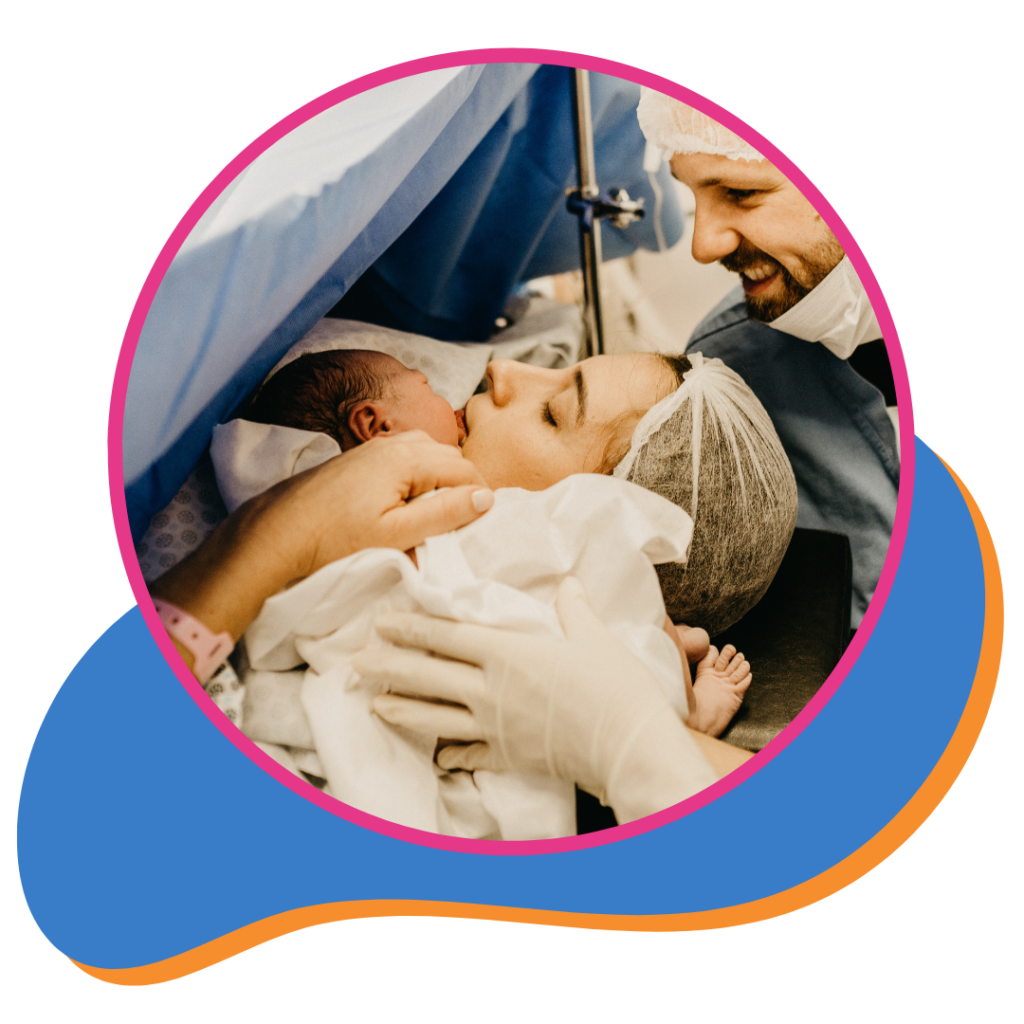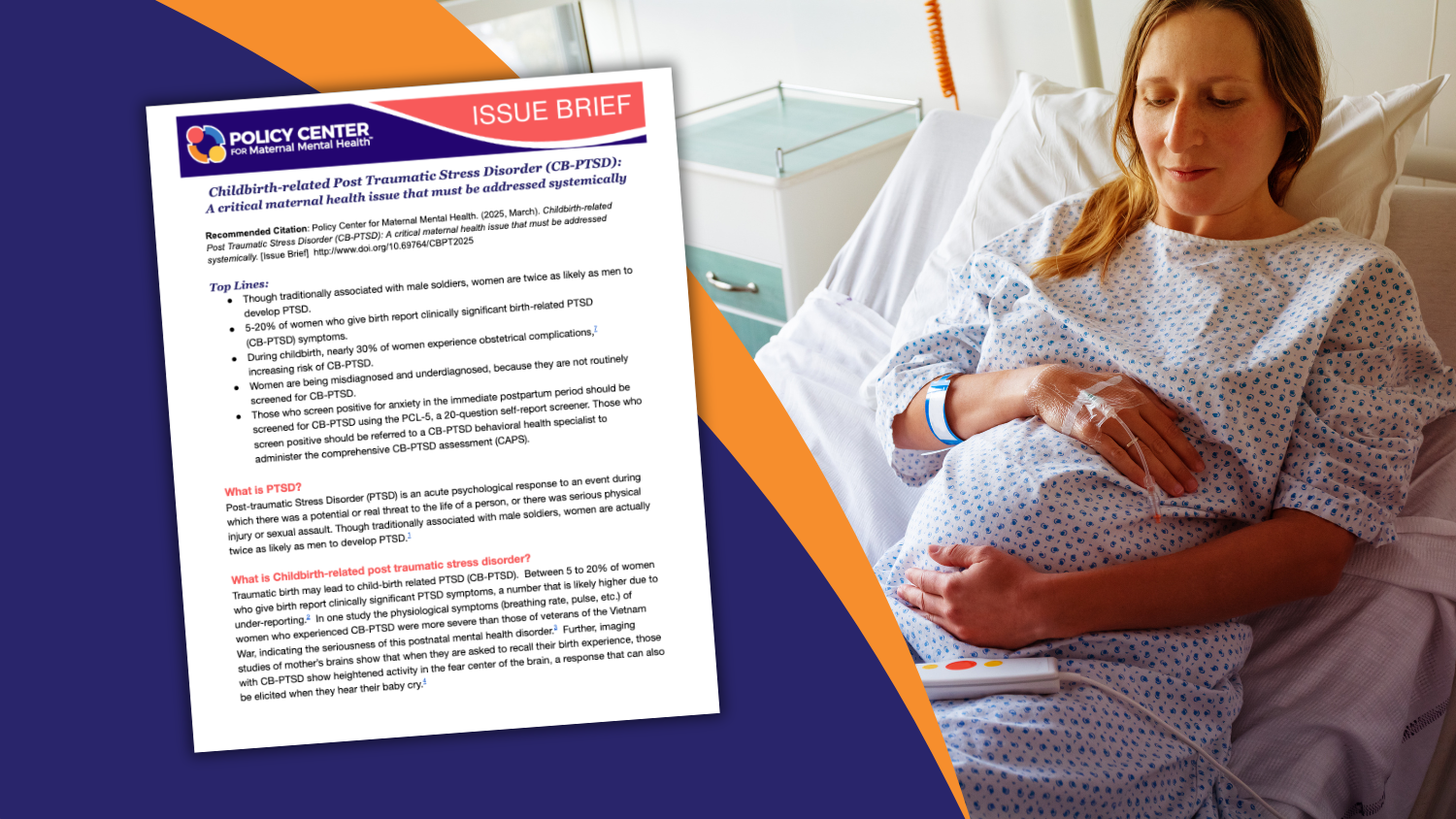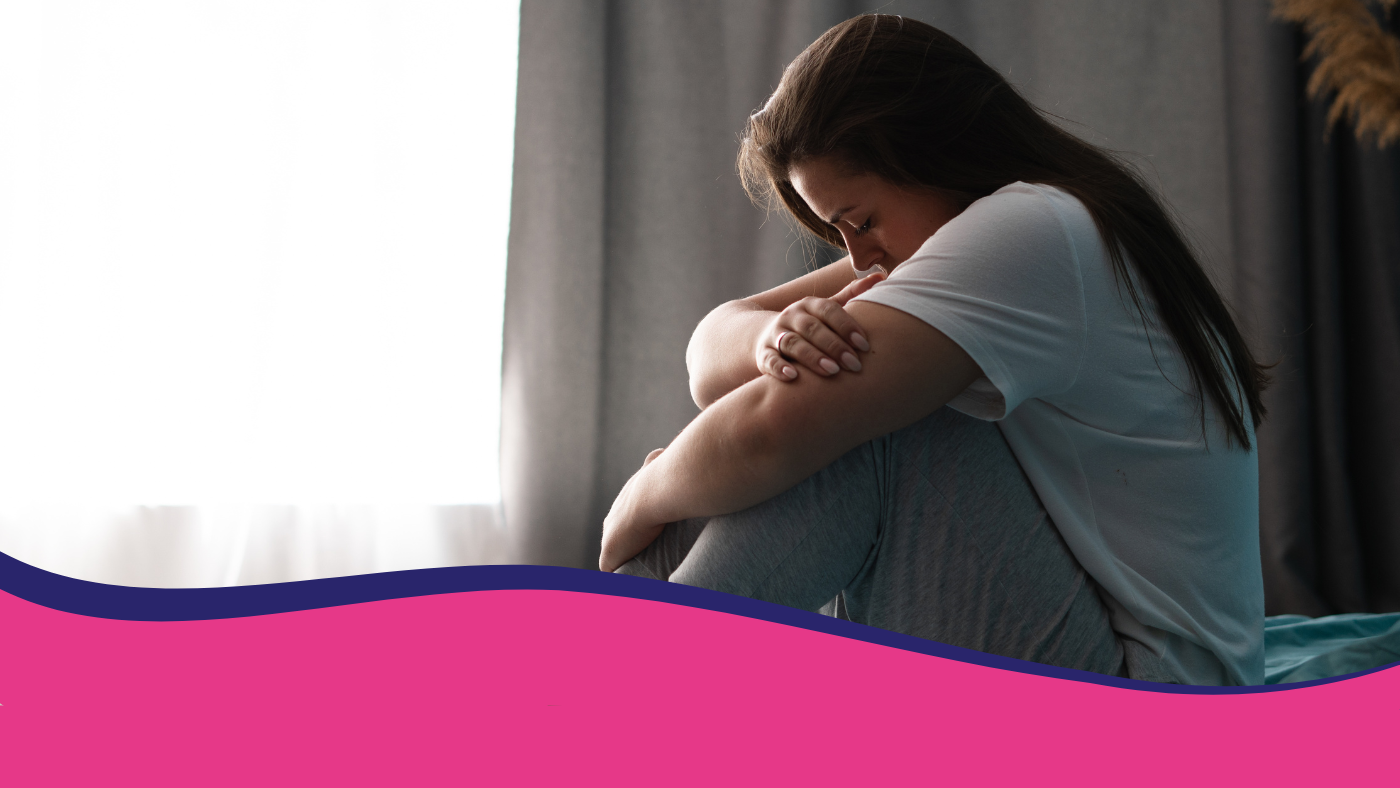Key Highlights
- Though traditionally associated with male soldiers, women are twice as likely as men to develop PTSD.
- 5-20% of women who give birth report clinically significant birth-related PTSD (CB-PTSD) symptoms.
- During childbirth, nearly 30% of women experience obstetrical complications, increasing risk of CB-PTSD.
- Women are being misdiagnosed and underdiagnosed, because they are not routinely screened for CB-PTSD.
- Those who screen positive for anxiety in the immediate postpartum period should be screened for CB-PTSD using the PCL-5, a 20-question self-report screener. Those who screen positive should be referred to a CB-PTSD behavioral health specialist to administer the comprehensive CB-PTSD assessment (CAPS).
Take it To Go
Recommended Citation: Policy Center for Maternal Mental Health. (2025, March). Childbirth-related Post Traumatic Stress Disorder (CB-PTSD): A critical maternal health issue that must be addressed systemically. [Issue Brief] http://www.doi.org/10.69764/CBPT2025
What is PTSD?
Post-traumatic Stress Disorder (PTSD) is an acute psychological response to an event during which there was a potential or real threat to the life of a person, or there was serious physical injury or sexual assault. Though traditionally associated with male soldiers, women are actually twice as likely as men to develop PTSD.1
What is childbirth-related post traumatic stress disorder?

Traumatic birth may lead to child-birth related PTSD (CB-PTSD). Between 5 to 20% of women who give birth report clinically significant PTSD symptoms, a number that is likely higher due to under-reporting.2 In one study the physiological symptoms (breathing rate, pulse, etc.) of women who experienced CB-PTSD were more severe than those of veterans of the Vietnam War, indicating the seriousness of this postnatal mental health disorder.3 Further, imaging studies of mother’s brains show that when they are asked to recall their birth experience, those with CB-PTSD show heightened activity in the fear center of the brain, a response that can also be elicited when they hear their baby cry.4
Symptoms of CB-PTSD
- Re-experiencing and reliving the trauma
- Feeling those sensations in response to a trigger, such as driving by the hospital where they gave birth
- Avoiding triggers that remind them of the birth, which can include the baby
- Hyperarousal: feeling jittery, being easily angered and irritable, having an increased heart rate, constantly looking for—or anticipating—danger, paranoia, inability to focus, difficulty sleeping5
What causes CB-PTSD?
Childbirth is a psychologically intense experience, even for the 72% of women who have medically uncomplicated deliveries.6 Nearly 30% experience obstetrical complications,7 which can be traumatic and increase their risk for developing CB-PTSD.
There are two primary contributing risk factors to CB-PTSD:
Objective stressors such as delivery complications, including unplanned caesarean deliveries and medical interventions, emergency c-sections, and medical complications for mom or baby. These disproportionately impact minoritized populations.
Subjective experience is how much a mother perceives her childbirth experience as life-threatening and the negative emotions the event triggers for her in the moment and when she recalls it.
What are the potential effects of CB-PTSD?
- As many as 90% of women who experience CB-PTSD also experience postpartum depressive symptoms.8
- Mother-infant bonding can be impaired, particularly if the baby becomes a trigger for a mother’s stress response.9
- There is some evidence of negative behavioral impacts in children.10
Risk factors for developing CB-PTSD:
- A history of trauma or PTSD, especially physical or sexual assault. However, only 20% of women who experience CB-PTSD have a history of trauma or PTSD.
- Unresolved mental health conditions prior to pregnancy and delivery.
- Giving birth prematurely doubles a mother’s risk of developing CB-PTSD.
- Experiencing obstetrical complications. For example, one in 5 women who deliver their babies by cesarean have symptoms of PTSD11 – three times the rate of women who deliver vaginally without complications.12
- Inadequate support during pregnancy and the postpartum period.13
Mothers of color:
Black, Latina, American Indian, and Asian and Pacific Islander women experience significantly higher rates of childbirth complications.14,15 Researcher Sharon Dekel, PhD, one of the country’s foremost researchers on CB-PTSD, found that Black and Latina women are three times more likely to perceive their childbirth experience as very stressful -independent of whether or not they experienced complications.16
Women are being misdiagnosed and underdiagnosed, because they are not routinely screened for CB-PTSD. The most common postpartum screening tool, the Edinburgh Perinatal Depression Scale, identifies symptoms of depression and general anxiety but not nuanced disorders such as CB-PTSD.
- PCL-5, a 20-question self-report screener should be provided to patients CB-PTSD. Those who screen positive should be referred to a behavioral health provider who specializes in CB-PTSD for administration of the CAPS assessment.
- Further the Clinician-Administered PTSD Scale (CAPS)—requires a 45-minute assessment by a mental health clinician who specializes in CB-PTSD.
How can we effectively predict CB-PTSD?
The most important predictor of CB-PTSD is how much childbirth was upsetting to the person delivering, according to Dr. Dekel. Using this understanding, Dekel conducted two forthcoming studies asking mothers to briefly describe their childbirth stories. Those descriptions were fed into a machine-learning model, which correctly identified 85% of women who actually had PTSD.17 This is significant, because this data could be used to identify women who should be given the PCL-5, a 20-question self-report screener to identifying CB-PTSD.18 Those who screen positive could then be referred to a behavioral health provider who specializes in CB-PTSD for administration of the CAPS assessment.
How can CB-PTSD be prevented and treated?
Research into preventing CB-PTSD during pregnancy and postpartum periods and treating it in the postpartum period is relatively new but rapidly expanding. Additional and larger studies are needed, but current research finds the immediate postpartum a very promising moment for intervention. Many of these interventions are low cost, low impact approaches that can be targeted to women most at risk:

- Educational interventions in the peripartum
- Structured trauma-focused therapies
- Semi-structured midwife-led psychological counseling
- Reprocessing of trauma memories through interventions such as EMDR and Trauma-Focused Expressive Writing
- Mother-infant dyadic focused interventions19
Recommendations for Clinical Settings
OBs and Women’s Health Providers
- Thoroughly discuss possible medical interventions with the patient and family/doula to help patients plan for possible complications and ensure decisions are made where possible, with the patient having adequate information and according to the patient’s wishes.
- Integrate maternal mental health (MMH) screening into routine prenatal and postpartum care in accordance with the American College of Obstetricians and Gynecologists’ Clinical Practice Guidelines
- Implement early screening/identification and intervention for birth trauma in the immediate postpartum period (1-5 days).
- Refer mothers who disclose symptoms of PTSD to providers or treatment programs developed by master’s-level or higher mental health providers, such as psychologists who specialize in CB-PTSD.
- Full assessment, diagnosis, and corresponding exposure therapy can be provided by psychologists trained in PTSD, exposure and EMDR therapy, and trauma.
Hospitals
- Adopt policies, and training/accountability measures among staff, to support the role of labor and delivery doulas and emphasize actively listening to and respectfully responding to mothers and their birth partners.
- Offer adequate pain management.
- Examine protocols for medical intervention and monitor quality improvement, referring to CMS guidelines (November 2024).
- Examine use of—and reduce when possible—medical interventions that increase risk for trauma.
- Provide patients/partners with a real-time ombudsman and retrospective grievance process.
- Review grievance and quality indicators such as HCAHPS maternity care patient-reported experience data and develop quality improvement programs to improve birth outcomes and reduce incidence of traumatic birth/CB-PTSD.
- Designate a support person, such as a social worker, treating nurse or physician to talk with women about their birth experience in the hospital and flag those with traumatic birth.
Policy Recommendations
State Medicaid and private insurers
Implement HRSA & ACOG Guidelines:
- Incentivize and monitor delivery of maternal mental health (MMH) screening/care and postpartum care through twelve months postpartum.
- Consider fee-for-Service (FFS) payment with pay-for-performance (P4P) Incentives.
- Track MMH Screening (HEDIS).
- Implement the 30-Day follow-up on positive MMH screens (HEDIS).
- Implement quality improvement interventions to incentivize change.
Policymakers:
- Build up Maternal Mental Health Workforce, including CB-PTSD Providers.
- Provide grants/scholarships to train additional master’s-level mental health providers and psychologists to support MMH including assessment and tx of CB-PTSD.
- Provide grants/scholarships to train additional master’s-level mental health providers and psychologists to support MMH, including assessment and treatment of CB-PTSD.
References
- Olff M. (2017). Sex and gender differences in post-traumatic stress disorder: an update. European Journal of Psychotraumatology, 8(sup4), 1351204. https://doi.org/10.1080/20008198.2017.1351204
↩︎ - Dekel, S. (2024, December 11). Birth Trauma: Understanding Its Origins and the Need to Do More. [Webinar] Policy Center for Maternal Mental Health, https://www.youtube.com/watch?v=6A6JfYyVchI. ↩︎
- Chan, S. J., Thiel, F., Kaimal, A. J., Pitman, R. K., Orr, S. P., & Dekel, S. (2022). Validation of childbirth-related posttraumatic stress disorder using psychophysiological assessment. American Journal of Obstetrics and Gynecology, 227(4), 656–659. https://doi.org/10.1016/j.ajog.2022.05.051
↩︎ - (Dekel, S. 2024, December 11)
↩︎ - Thiel, F., Ein-Dor, T., Dishy, G., King, A., & Dekel, S. (2018). Examining Symptom Clusters of Childbirth-Related Posttraumatic Stress Disorder. The Primary Care Companion for CNS Disorders, 20(5), 18m02322. https://doi.org/10.4088/PCC.18m02322
↩︎ - Declerg, E. and Zephyrin, L. (2021) Maternal Mortality in the United States: A Primer. Commonwealth Fund. https://www.commonwealthfund.org/publications/issue-brief-report/2020/dec/maternal-mortality-united-states-primer ↩︎
- (Leclerq, et al., 2021) ↩︎
- Dekel, S., Ein-Dor, T., Dishy, G. A., & Mayopoulos, P. A. (2020). Beyond postpartum depression: posttraumatic stress-depressive response following childbirth. Archives of Women’s Mental Health, 23(4), 557–564. https://doi.org/10.1007/s00737-019-01006-x
↩︎ - Dekel, S., Thiel, F., Dishy, G., & Ashenfarb, A. L. (2019). Is childbirth-induced PTSD associated with low maternal attachment?. Archives of Women’s Mental Health, 22(1), 119–122. https://doi.org/10.1007/s00737-018-0853-y
↩︎ - Van Sieleghem, S., Danckaerts, M., Rieken, R., Okkerse, J. M. E., de Jonge, E., Bramer, W. M., & Lambregtse-van den Berg, M. P. (2022). Childbirth related PTSD and its association with infant outcome: A systematic review. Early Human Development, 174, 105667. https://doi.org/10.1016/j.earlhumdev.2022.105667
↩︎ - (Dekel, S. et al., 2020) ↩︎
- (Dekel, S. et al., 2020) ↩︎
- Khsim, I. E. F., Rodríguez, M. M., Riquelme Gallego, B., Caparros-Gonzalez, R. A., & Amezcua-Prieto, C. (2022). Risk Factors for Post-Traumatic Stress Disorder after Childbirth: A Systematic Review. Diagnostics (Basel, Switzerland), 12(11), 2598. https://doi.org/10.3390/diagnostics12112598
↩︎ - (Leclerq, et al., 2021) ↩︎
- Kozhimannil, K. B., Interrante, J. D., Tofte, A. N., & Admon, L. K. (2020). Severe Maternal Morbidity and Mortality Among Indigenous Women in the United States. Obstetrics and Gynecology, 135(2), 294–300. https://doi.org/10.1097/AOG.0000000000003647
↩︎ - (Dekel, S. 2024, December 11) ↩︎
- (Dekel, S. 2024, December 11) ↩︎
- Arora, I. H., Woscoboinik, G. G., Mokhtar, S., Quagliarini, B., Bartal, A., Jagodnik, K. M., Barry, R. L., Edlow, A. G., Orr, S. P., & Dekel, S. (2024). A diagnostic questionnaire for childbirth related posttraumatic stress disorder: a validation study. American Journal of Obstetrics and Gynecology, 231(1), 134.e1–134.e13. ↩︎
- Dekel, S., Papadakis, J. E., Quagliarini, B., Jagodnik, K. M., & Nandru, R. (2023). A Systematic Review of Interventions for Prevention and Treatment of Post-Traumatic Stress Disorder Following Childbirth. medRxiv : the preprint server for health sciences, 2023.08.17.23294230. https://doi.org/10.1101/2023.08.17.23294230
↩︎
Contributors
Report Writing: Kate Rope, Policy Center
Conceptualization, Topic Supervision, Policy Writing: Joy Burkhard, Policy Center
Copy Editor: Cindy Herrick

